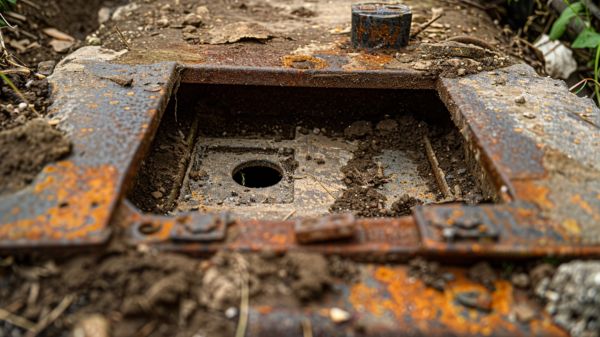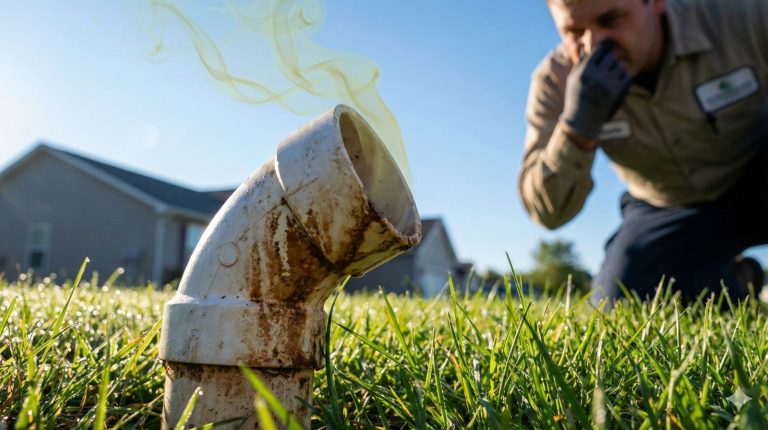Understanding septic tank distribution box problems is essential for peak system performance. Distribution boxes act as important junctions, ensuring uniform effluent distribution to prevent system overload. Signs of issues include odors, slow drainage, and standing water. Regular inspection and maintenance are key.
The outlet pipe’s location is critical for proper flow management. Drain fields play a pivotal role in wastewater treatment. Soil type influences wrapping necessity. Consider drainage efficiency based on soil characteristics. Ensuring system efficiency involves regular checks and prompt repairs.
Prevention is key. Adhering to maintenance tips and early action are essential. Further insights into addressing and preventing problems are explored in the full guide.
Key Takeaways
- Importance of Distribution Boxes in septic systems for efficient effluent distribution.
- Signs of Distribution Box Problems like odors, backups, and standing water.
- Locating Outlet Pipe near the distribution box for flow management.
- Role of Drain Fields in final treatment and disposal of wastewater.
- Controversies on Wrapping Systems based on soil types and regional needs.
Importance of Distribution Boxes
The significance of distribution boxes within septic systems lies in their pivotal role as essential junction points that facilitate the uniform distribution of effluent from the septic tank to various drain fields.
These boxes are vital for ensuring the efficiency of the entire septic system by evenly dispersing wastewater to different sections of the drain field. By distributing effluent in a balanced manner, distribution boxes prevent any single drain field from becoming overloaded, thereby promoting excellent absorption and preventing system failure.
Regular maintenance and inspection of distribution boxes are imperative to guarantee their proper functioning. Neglecting maintenance can lead to clogs, backups, and uneven distribution of effluent, which may result in costly repairs and system downtime.
Understanding the importance of distribution boxes empowers homeowners and professionals to prioritize their upkeep, identifying potential issues early on and intervening promptly. This proactive approach not only ensures the longevity of the septic system but also contributes to its overall efficiency and effectiveness in wastewater treatment.
Signs of Distribution Box Problems
Indications of potential distribution box malfunctions can manifest through various observable cues in and around the septic system. Foul odors or sewage backup in the yard are common signs of distribution box issues, indicating a possible blockage or overflow.
Slow draining fixtures or gurgling sounds in the plumbing may also signal problems within the distribution box, requiring immediate attention to prevent further complications. Additionally, lush, green patches of grass over the distribution box area could signify a leak or overflow, highlighting the necessity for immediate inspection and repair.
Standing water or damp soil around the distribution box is another clear indicator of a malfunction, necessitating thorough investigation to identify and address the underlying issue. To address distribution box problems, common solutions include inspecting for clogs, repairing damaged components, and ensuring proper drainage.
Troubleshooting methods involve checking the inlet and outlet pipes for blockages, examining the distribution box for structural integrity, and maintaining regular maintenance schedules to prevent costly septic system failures. Regular inspection and maintenance play an important role in identifying distribution box problems early and mitigating potential risks to the septic system.
Locating the Outlet Pipe
Efficient diagnosis and resolution of septic tank distribution box issues often necessitate pinpointing the precise location of the outlet pipe, an essential component for proper wastewater flow management. The outlet pipe can be located by using a probe to trace its path from the septic tank to the distribution box, typically found near the distribution box for effective drainage and effluent distribution.
In some instances, a corrugated pipe is utilized to connect the septic tank to the distribution box, which may require maintenance or patching. Understanding the location and condition of the outlet pipe is critical for diagnosing and resolving septic tank distribution box problems.
Proper maintenance of the outlet pipe is crucial to ensure the smooth flow of wastewater from the septic tank to the drain field through the distribution box. Techniques such as regular inspection and timely pipe repair are essential for preventing outlet pipe malfunctions and maintaining the overall functionality of the septic system.
Role of Drain Fields
In the context of septic tank distribution box maintenance, a key element that plays a significant role in the proper functioning of the system is the drain field. The drain field serves as the final stage of wastewater treatment and disposal within the septic system. It consists of perforated pipes surrounded by gravel, allowing the treated water to seep into the soil for further purification.
The gravel in the drain field not only aids in distributing the effluent evenly but also enhances water percolation, ensuring efficient drainage. Different soil types influence the percolation process, affecting the overall drainage efficiency of the septic system. The perforated pipes in the drain field are essential as they disperse the treated water into the surrounding soil, completing the treatment cycle.
Understanding the components and functioning of the drain field is paramount for maintaining a well-operating septic system that effectively treats and disposes of wastewater.
Controversies on Wrapping Systems
Wrapping systems in septic tank distribution boxes have sparked debate within the industry, as opinions differ on their necessity and effectiveness. The wrapping controversy arises from the varying soil compositions found in different regions.
For instance, in Florida, where sandy soil prevails, wrapping systems are commonly employed to prevent sand migration into the distribution box. In contrast, regions like North Carolina, characterized by clay soil, may not require wrapping systems due to the soil’s natural properties that inhibit sand infiltration.
The decision to use wrapping systems in distribution boxes hinges greatly on the soil composition of the area. Understanding the specific soil type and its drainage capabilities is important in determining whether a wrapping system is essential. By tailoring the use of wrapping systems to the specific soil conditions, septic system professionals can make informed decisions that optimize the performance and longevity of distribution boxes.

Considering Soil Types
The soil type plays a vital role in determining the necessity of wrapping the distribution box system. Factors such as soil permeability can greatly impact the drainage efficiency of the septic system. Additionally, understanding soil characteristics is essential in determining the best placement of the distribution box for effective water distribution.
Soil Permeability Factors
Considering the unique characteristics of various soil types, understanding soil permeability is fundamental in the meticulous design and implementation of septic systems. Soil analysis and percolation rates play a critical role in determining the suitability of a site for a septic system. Here are some key points to keep in mind:
- Sandy soils like those in Florida may require wrapping the drain field pipes to prevent sand migration.
- Clay soils, such as those in North Carolina, with natural filtration properties, may not necessitate wrapping the drain field pipes.
- Designing an effective septic system requires a thorough understanding of the soil type to ensure excellent performance and longevity.
- Varying soil compositions across regions may dictate different requirements for drain field pipe wrapping to mitigate risks of clogging or damage.
Impact on Drainage
In septic systems, the impact of distribution box problems on drainage efficiency is greatly influenced by the underlying soil type. Soil composition plays an essential role in drainage optimization within the system, affecting water flow and clogging risks.
Sandy soil tends to facilitate faster water flow, potentially leading to clogging issues within the distribution box. Conversely, clay soil presents challenges in water absorption and distribution, impacting overall drainage performance. To address distribution box problems effectively, understanding the soil composition is important.
Proper maintenance and timely repairs of the distribution box are essential for ensuring efficient drainage, regardless of the soil type present in the septic system.
| Soil Type | Impact on Drainage |
|---|---|
| Sandy | Faster water flow, potential clogging issues |
| Clay | Water absorption challenges, distribution issues |
Distribution Box Placement
Given the significant influence of soil type on drainage efficiency in septic systems, strategic placement of distribution boxes becomes imperative to optimize water distribution within the system. When considering distribution box placement in septic systems, several factors related to soil types should be taken into account:
- Well-draining Soil: Make sure distribution boxes are placed in areas with good drainage to facilitate proper water distribution.
- Sandy Soil Considerations: In sandy soil, elevate distribution boxes to prevent clogging issues.
- Clay Soil Considerations: In clay soil, position distribution boxes at a lower elevation to promote efficient water flow.
- Soil Characteristics: Understanding the soil composition is crucial for determining the most suitable placement of distribution boxes for effective wastewater treatment.
Multiple Outlet Distribution Boxes
Utilizing multiple outlets in distribution boxes allows for efficient diversion of wastewater to various drain fields, optimizing the functionality and performance of the septic system. These multiple outlet distribution boxes enable the regulation of flow, ensuring that each drain field receives an appropriate amount of effluent.
This feature is particularly beneficial when considering drain field expansion or maintenance, as it allows for the addition of multiple drain fields without compromising the system’s efficiency.
Ensuring System Efficiency
To maintain peak functionality and performance of a septic system, guaranteeing system efficiency through regular maintenance of the distribution box is paramount.
- Regular Inspection: Conduct routine checks for clogs and blockages within the distribution box to prevent backups and failures.
- Proper Leveling: Verify the distribution box is correctly leveled to promote the even distribution of wastewater to the drain field.
- Component Maintenance: Address any signs of damage or wear in the distribution box components promptly to prevent leaks and maintain system efficiency.
- Understanding Functionality: Familiarize yourself with the distribution box’s role in the septic system to identify and resolve potential issues early on.
Addressing Distribution Box Issues
In troubleshooting septic system problems, a vital aspect often requiring immediate attention is the identification and resolution of distribution box problems. Distribution boxes play an essential role in guaranteeing the proper distribution of effluent to the drain field.
When issues arise with the distribution box, such as clogging or uneven distribution, it can lead to system failures and costly repairs if not addressed promptly. To effectively address distribution box problems, homeowners can utilize troubleshooting techniques and DIY solutions.
Common misconceptions about distribution boxes can sometimes lead to improper maintenance or neglect. Seeking expert advice can provide homeowners with the necessary knowledge to maintain and address distribution box issues effectively.
Regular inspection and cleaning are essential to prevent system backups and maintain overall system functionality.
| Troubleshooting Techniques | DIY Solutions | Expert Advice |
|---|---|---|
| Check for leaks | Inspect for clogs | Seek professional help |
| Ensure proper flow | Clean the box | Understand system dynamics |
| Use dye tests | Maintain proper cover | Follow manufacturer guidelines |
Preventing Future Problems
To prevent future distribution box problems, adherence to regular maintenance tips is essential. Early warning signs such as slow drainage should prompt immediate inspection and action to avoid major issues. Professional inspections play an important role in identifying potential problems early on, ensuring the longevity and efficiency of the septic system.
Regular Maintenance Tips
Regularly inspecting the distribution box for signs of damage or clogging is crucial in preventing future septic tank issues. Here are some maintenance tips to help keep your septic system running smoothly:
- Maintenance Frequency: Pump out the distribution box every 3-5 years to remove accumulated solids and guarantee proper drainage.
- Avoid Planting Near the Box: Prevent root intrusion by refraining from planting trees or shrubs near the distribution box, as roots can lead to blockages.
- Clear Surrounding Area: Keep the area around the distribution box free of debris and soil to allow easy access for maintenance and inspections.
- Monitor Water Flow: Regularly check the water flow in the distribution box to catch any potential problems early on and avoid costly repairs.
Early Warning Signs
Inspecting the distribution box for early warning signs can help proactively prevent potential septic tank issues. Foul odors around the distribution box area are a common indication of underlying problems. Monitoring for pooling water or soggy ground nearby can reveal drainage issues.
Gurgling sounds in the plumbing system may signal blockages in the distribution box or pipes. Regular inspections should check for leakage signs like damp soil or standing water around the box. Slow drains or backups in the house could also point to distribution box problems.
Understanding these warning signs can dispel common misconceptions and enable homeowners to employ effective troubleshooting techniques to address septic system issues promptly.
Professional Inspection Importance
Detecting distribution box problems early through professional inspections is crucial for preventing costly septic system repairs and ensuring long-term functionality.
Benefits of Professional Inspections:
- Early Problem Identification: Inspections can detect issues before they escalate, saving money on extensive repairs.
- System Functionality: Guarantees the proper operation of the septic system by detecting outlet or connection problems in the distribution box.
- Preventative Maintenance: Early detection helps avoid drain field damage or septic tank overflow, which can result from distribution box issues.
- Expert Recommendations: Professionals can evaluate outlet flow distribution, preventing drainage problems and providing suggestions for top-notch system performance.
Frequently Asked Questions
What Is the Problem With the Distribution Box Septic System?
An essential component of a septic system, the distribution box can face issues like clogging or damage, hindering proper effluent distribution. Regular maintenance and troubleshooting help prevent malfunctions, avoiding costly repairs and ensuring system efficiency.
How to Unclog a Septic Distribution Box?
To unclog a septic distribution box, consider using a plumbing snake, inspect for debris or buildup, and utilize high-pressure water jetting if needed. For persistent clogs, seek professional septic tank service. Regular maintenance is key to preventing issues.
How Does a Septic Tank Distribution Box Work?
The septic tank distribution box functions as a pivotal component in the drainage system, dividing effluent from the septic tank into multiple drain fields for even distribution. This guarantees balanced wastewater flow, preventing overload and optimizing treatment efficiency.
What Is the Most Common Cause of Septic System Failure?
The most common cause of septic system failure is a compromised drain field. Pump failure can also contribute to system breakdown. Understanding these issues and addressing them promptly through professional maintenance can prevent costly repairs and health risks.
Conclusion
In conclusion, understanding septic tank distribution box problems is essential for maintaining the efficiency of the entire septic system. By identifying signs of issues, locating the outlet pipe, and addressing problems promptly, homeowners can prevent costly repairs and guarantee the proper functioning of their septic system.
It is important to regularly inspect the distribution box and take necessary measures to prevent future problems from arising. Regular maintenance is key to the longevity and effectiveness of the septic system.





